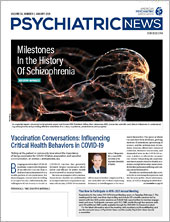The COVID-19 pandemic has brought with it an increase in depression, anxiety, and fears that the country may see a rise in the incidence of suicide. An average of 17 veterans die by suicide a day, according to the Veterans Health Administration’s (VHA) 2020 Veteran Suicide Prevention Annual Report, released in November 2020. Yet, so far, the pandemic has not coincided with a rise in veteran suicide.
The report included results from assessments of suicide-related behaviors reported at VHA sites from March to September 2020. The findings did not suggest that reported suicides, nonfatal suicide attempts, or the volume of emergency department (ED) visits related to suicide had increased during that period. In fact, beginning in March, ED visits for suicide attempts decreased among veterans compared with last year.
Some Veterans Report Mental Health Problems
While so far the COVID-19 pandemic hasn’t led to an increase in the incidence of suicide among veterans, the 2020 suicide prevention report noted that monitoring is ongoing. Just like in the general population, many veterans have reported worsening mental health. From May 5 to June 19, the Wounded Warrior Project conducted a survey of 28,282 veterans. Over 60% of the respondents agreed with the statement, “I feel more disconnected from my family, friends, or community,” and 51.9% agreed that their mental health was worse since physical distancing began.
Jenny Boyer, M.D., J.D., Ph.D., said some of the patients she sees at the West Texas VA Health Care System have been more isolated due to the pandemic. “There’s a decline in mood that I’ve noticed, and it’s in part because of added financial stress,” said Boyer. “They’re struggling to provide for themselves, their families, and even feed the dog.” She is APA’s Area 5 trustee.
Veterans have been hit hard by the pandemic’s economic ramifications. According to the 2020 suicide prevention report, unemployment has increased among veterans. There were 833,000 more unemployed veterans in April 2020 compared with the year before, from 2.3% to 11.7%.
Yet Boyer and Warren “Grant” Harbison, M.D., chief of psychiatry at the Boise VA Medical Center, also noted that the pandemic may look different to patients with posttraumatic stress disorder (PTSD). These patients are often uncomfortable being in public amid strangers. “One response I’ve seen from many of my patients is that they were totally comfortable with staying at home because part of PTSD involves social isolation,” Harbison said. “Many veterans, especially in places like Idaho, where the population density is low, really appreciate the ability to be on their own and not have to be around other people.”
Estimates of the prevalence of PTSD among veterans vary, especially between different wars, with estimates ranging from 13.5% to 30% for Iraq and Afghanistan veterans.
Congress Addresses Veteran Mental Health
As the pandemic continues, Congress has taken some action to improve psychiatric services for veterans. Last year, Congress passed the Commander John Scott Hannon Veterans Mental Health Care Improvement Act of 2019 (S 785) and the Veterans Comprehensive Prevention, Access to Care, and Treatment (COMPACT) Act of 2020 (HR 8247). The bills both focus on preventing veteran suicide and address a range of issues related to veterans’ mental health care, including ensuring veterans can access the care they need.
APA’s Department of Government Relations and Division of Policy, Programs, and Partnerships worked with legislators to craft a section of S 785 that requires the departments of Veterans Affairs and Defense to establish clinical practice guidelines to treat veterans with serious mental illnesses within two years. The serious mental illnesses are schizophrenia; schizoaffective disorder; persistent mood disorder (including bipolar disorder I and II); and any other mental, behavioral, or emotional disorder “resulting in serious functional impairment that substantially interferes with major life activities,” as determined by the secretaries of Defense and Health and Human Services, according to the law.
The guidelines must include a list of evidence-based therapies and guidance for administering pharmacological, psychological, or behavioral therapies. S 785 also requires the secretaries of Veterans Affairs, Defense, and Health and Human Services to create a work group to develop the clinical practice guidelines. The work group must be composed of individuals representing both federal government and nongovernment entities.
“APA is pleased to see Congress focusing on veterans’ suicide prevention and mental health, and we are encouraged that lawmakers have recognized the importance of addressing these urgent issues,” said APA CEO and Medical Director Saul Levin, M.D., M.P.A. “We look forward to continuing our work with the VA, Congress, and partner organizations to improve the mental health and substance use care available to our veterans.”
Veterans’ Transition to Telepsychiatry
For many VHA sites, telehealth is not new. Harbison noted that his staff in Boise, Idaho, have been providing telepsychiatry to patients in rural parts of Idaho for years. Since the pandemic began, though, many more VHA patients began to use VA Video Connect (VVC), a telehealth program, to access care. “In the five months prior to the pandemic, VHA mental health providers averaged approximately 146 VVC group psychotherapy visits a month,” the 2020 suicide prevention report states. “In September, more than 84,500 VVC group encounters were completed.”
For established patients, Boyer said that telehealth has been valuable because they already have a therapeutic relationship and can pick up where they left off. But like many other psychiatrists across the country, seeing new patients via telemedicine can be challenging. “We’ve had a lot of new patients because a lot of people are losing their jobs and their private insurance,” she said.
All psychiatrists, she said, must give themselves credit for the work they are doing. “I’m encouraged by how people are surviving, the stories I hear from my patients, and how hopeful they are,” she said. ■



